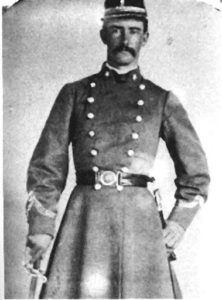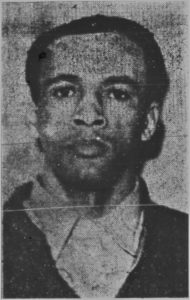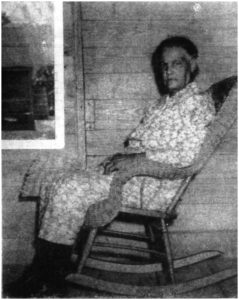…Two figures ever stand to typify that day to coming ages,—the one, a gray-haired gentleman, whose fathers had quit themselves like men, whose sons lay in nameless graves; who bowed to the evil of slavery because its abolition threatened untold ill to all; who stood at last, in the evening of life, a blighted, ruined form, with hate in his eyes;—and the other, a form hovering dark and mother-like, her awful face black with the mists of centuries, had aforetime quailed at that white master’s command, had bent in love over the cradles of his sons and daughters, and closed in death the sunken eyes of his wife,—aye, too, at his behest had laid herself low to his lust, and borne a tawny man-child to the world, only to see her dark boy’s limbs scattered to the winds by midnight marauders riding after “damned Niggers.” These were the saddest sights of that woeful day; and no man clasped the hands of these two passing figures of the present-past; but, hating, they went to their long home, and, hating, their children’s children live today.
– W.E.B. DuBois, writing of the post-War period, in The Souls of Black Folk (1903)
In 1864, the third year of the Civil War, Christine-Amélia Armant Becnel lost her husband, Pierre-Lézin Becnel, and her brother, Ludger-Léopold Armant, who both died in battle while serving in the Confederate Army. Letters from comrades of her late husband and words penned by the family priest all ascribed the glory of martyrdom to the death of her husband and the similar death of her brother:
“We cry with you [for] the noble victim who sacrificed himself for the cause so sainted and so sacred … Often I think to the heroic martyr of Mansfield.” – Father V. M. Mina
The ‘hero of Mansfield’ elegized by Father Mina was her brother, Ludger-Leopold Armant who died at the Battle of Mansfield, Louisiana on 8 April 1864 at twenty-eight years of age. Léopold Armant was born in 1838 on his family’s sugar plantation on the west bank of Saint James Parish. He was a graduate of Georgetown and the University of Louisiana (predecessor to Tulane) as well as a former student of the University of Virginia. He returned to his native Louisiana and practiced law and entered the State Legislature before the outbreak of the Civil War. Upon joining the 18th Louisiana Infantry, Armant quickly rose from First Lieutenant to Captain to Major to Colonel in July 1862. He was a veteran of Shiloh, Corinth, Labadieville, and Fort Bisland. He met his fate in the Battle of Mansfield, during the Red River Campaign, boldly advancing with his men rather than remaining in reserve. Seeing his regimental colors about to fall, he rushed forward to retrieve them and rallied his men on, even after his horse had been shot from under him. He received a fatal wound to the chest, yet with his dying breath still struggled to hold up the flag and rally his men onward. He was initially buried at field but later reinterred in his native parish amid his kinsmen.

Ludger-Léopold Armant (1835-1864)
Four months after Léopold Armant’s fall at Mansfield, his sister’s husband, Lézin Becnel, met the same fate at the Battle of Atlanta. Amélia Armant Becnel took solace in her Catholic faith and used it and the thought of martyrdom for the South to make sense of her losses.
Nearly eight decades later, another Armant woman and her family turned to their Catholic faith and to the thought of martyrdom for the South to make sense of their loss.
On the morning of 30 January 1943, the seven surviving siblings of Hugh Pierre; his inconsolable wife and mother of his three children; and other relatives assisted at Mass and received Holy Communion with him and accompanied him as he made the Way of the Cross. Old age and debilitating grief prevented his mother, Philomène Armant Pierre, from joining them, yet one can imagine the aged mother in her modest home along the River Road, clutching her Rosary beads as the dreaded hour of her son’s death approached.
Amélia Armant Becnel had fortified herself through prayer for three years after her male kin entered the Civil War. Philomène Armant Pierre had prayed incessantly for seven years since her son’s ordeal began. Like the women of Jerusalem their Jesus met on the way to Calvary, His words were a prescient admonishment to them, “Weep not for me, but for yourselves and your children.”
The enmity between the children of the aged gentlemen of the Old South and the children of the aged Black mother, described by DuBois, found itself reified in the legal system and the (mis)carriage of justice in the Jim Crow South.
Léopold Armant died in defense of the South and the preservation of its peculiar institution of slavery. Hugh Pierre died after having secured, in reality, a right for his people which, in theory, had long since been guaranteed by the Fourteenth Amendment. The “honor” of dying in the interest of the South befell this family twice, inasmuch as Hugh Pierre was the grandson of Colonel Léopold Armant.
Though the young attorney Léopold Armant had not yet married by the start of the Civil War, he did have a mulatto daughter named Philomène with an enslaved woman named Marianne (Campbell). In fathering children with women of color, Léopold followed the example of his father, grandfather, and at least three of his uncles. Léopold’s mulatto daughter, who was born in 1861 or 1862, never knew her brave father, yet she knew his name and shared it with children.
Philomène married Célestin Pierre fils of Saint John the Baptist Parish on 11 September 1879 at Saint James Church. They settled among his relatives in Lucy, about sixteen miles downriver from Philomène’s home in Saint James Parish. Over the thirty-five years of their marriage, they had ten surviving children – six daughters and four sons. Their youngest child was born on 25 October 1902, and was baptized Crespin-Hugues Pierre, on 26 December 1903 at Saint John the Baptist Church at Edgard. While Célestin and Philomène were both native French speakers, their children’s primary language was English and their youngest son’s name was usually rendered “Hugh.” This son was disabled by infantile paralysis.
In 1932, Hugh Pierre found a broken plow along the Mississippi River levee. He brought the plow back to the home he shared with his widowed mother, repaired it, and used it for four years. On October 20, 1936, Leopold Ory, a butcher, confronted Pierre and claimed that the plow was one which had been stolen from him four years before. An altercation ensued between Ory and Pierre, in which Ory suffered a few blows. He hastily went to the justice of the peace to file charges against Pierre. That night Constable Ignace Roussell gathered a group of men and proceeded to the Pierre home. Pierre, knowing all too well the consequences for striking a white man, feared for his life. When the group, which he thought a lynch party, barged into his home without a warrant, he fired his shotgun resulting in the death of Constable Roussell. The crippled Pierre fled but was soon discovered hiding in a woodpile in a neighboring parish. Pierre was initially indicted and convicted by petit and grand juries which did not include blacks.
His attorney, Maurice R. Woulfe, appealed the indictment and conviction all the way to the U. S. Supreme Court, where he successfully showed that Negroes had been systematically excluded from juries in St. John the Baptist Parish from 1896 to 1936. In giving the Court’s opinion, which was decided in February 1939, Justice Hugo Black cited the Court in an earlier case (Virginia v. Rives), “It is a right to which every colored man is entitled, that, in the selection of jurors to pass upon his life, liberty, or property, there shall be no exclusion of his race, and no discrimination against them because of their color.” The decision in Pierre v. Louisiana brought about an end to the systematic exclusion of blacks from juries in Louisiana.
Over the next four years, Hugh Pierre was re-indicted three times and his case was appealed to the U. S. Supreme Court twice on various contentions, including that too few black jurors were selected and the illegality of a change in Louisiana’s execution law by the state legislature. Pierre’s case gained local and national attention in the black press, particularly The Louisiana Weekly, The New Orleans Sentinel, and The Pittsburgh Courier, thanks to the interest of Courier correspondent, educator, and civic leader O.C.W. Taylor. Promoting Hugh’s cause was his sister, Septima Pierre Schexnaydre Wiltz. Dances, raffles, and other fundraisers were held to fund his defense. Black organizations such as the Knights of Peter Claver also made contributions to his defense fund. Ultimately, the Supreme Court denied his third appeal in November 1942 and appeals to the State Pardon Board for clemency proved in vain.

Hugh Pierre (1902-1943)
On 30 January 1943, Hugh Pierre, having by his own statement, “made my peace with God,” calmly approached the then-two-year-old “Gruesome Gertie,” Louisiana’s storied electric execution chair. 2,300 volts of electricity were sent through his body and at 12:19 p.m. he was declared dead. By 12:25, the chair was loaded up and ready to be returned to Angola. The remains of Hugh Pierre were first laid out at his brother’s home in Lucy, before he was transported to New Orleans. He was buried with a Requiem Mass in Corpus Christi Church and interred in Mount Olivet Cemetery. His grieving wife, Lucille LaGrue Pierre, made the journey to New Orleans for his burial, while his three children ranging in age from six to ten were left at the home they shared with Mrs. Pierre’s parents in Killona.
Albert Pierre, one of Hugh’s two surviving brothers, made this statement:
“I am sorry for my brother’s death. We fought this case for six years and three months, but I am happy for one thing. We made it possible to have Negroes serve as grand jurors again.”
Hugh Pierre’s mother, Philomène Armant Pierre, survived him by six years, dying on 26 July 1950.

Philomène Armant Pierre (~1862-1950)
Léopold Armant laid down his life in defense of the Southern cause in a war which the South lost, after four long years of incomprehensible bloodshed. Yet, it has often been said that “the North won the War, but the South won the peace.” Hugh Pierre died after seeking justice and due process in that postbellum South. His death was but one of thousands of deaths due in one way or another to hatred and race prejudice, which ultimately cannot be legislated away.
Just as fervently as Amélia Armant and Philomène Armant prayed for their lost loved ones, let us both work and pray that, more than a century after DuBois’ incisive observations, the great-great-grandchildren and great-great-great-grandchildren of those two iconic, living relics of war-torn days will declare lasting peace.
Jari C. Honora
Sources: The Pittsburgh Courier, 13 May 1939, p. 6; The Louisiana Weekly, 4 March 1939, pp. 1,4; 10 August 1940, pp. 1,5; 17 October 1942, pp. 1,7; 19 December 1942, p. 1; 6 February 1943, pp. 1,6; The New Orleans Sentinel, 3 August 1940, pp. 1,6; 10 August 1940, pp. 1,8; The New Orleans Item, 16 January 1942, p. 1; Katy F. Morlas, “La madame et la mademoiselle: Creole Women in Louisiana, 1718-1865” (2005) LSU Master’s Thesis, pp. 87-90; “Leopold L. Armant,” 18th Louisiana: The Veterans, Joe Richard (http://members.tripod.com/j_richard/index1.html: accessed 1 August 2020); “Leopold Ludger Armant (10 June 1835-8 April 1864)” Students of the University of Virginia, Jean L. Cooper (https://uvastudents.wordpress.com/2011/05/28/leopold-ludger-armant-10-june-1835-8-apr-1864/: accessed 1 August 2020).



This is a beautiful piece. I have some Pierre 2nd cousins on my Dad’s side. I’ll pass this on.
Excellent article and history. Thanks for sharing.
Outstanding research and Superb presentation from Jari.
Thank- you!
This is my great uncle and he would have wanted his story told ! Thank you Jari you did wonderful!!! Fotever grateful.
This is amazing to find out history about my family.
Hugh Pierre is my Grandfather!! I’m
1 of 3 sons of his Daughter Shirley Pierre Meyers !!!
Incredibly heart -pounding Article !
I appreciate all that’s involved !
appreciate all
Mr. Hugh Pierre was my uncle. He was married to my aunt, Lucille Lagrue. I’m a first cousin to Mr. Pierre’s three children. It is very good to know about my family tree. I would love to find out more.
Is the story true, that Léopold Armant was betrothed to his neighbor, Anna Fortier, before the War?
Glenn: The oldest source I can find for Léopold’s engagement to Anna Fortier is from Miss Lillian Bourgeois’ 1957 book Cabanocey. I assume that Miss Bourgeois received this information as oral history. Anna Fortier didn’t die until 1930, when she was almost 90, so Miss Bourgeois may have even known her personally. – By the way, I didn’t mention it in the article, but I am descended from Léopold’s uncle, Sosthène Armant. Such a small world in the River Parishes!
Any thoughts on the legitimacy of the Armant-Fortier story? It seems doubtful that Armant was involved in two relationships at one time. But maybe the War’s unknowns contributed to it.
Glenn: I don’t think it’s all that hard to imagine. His association with Marianne may have lasted a while or it could have been a one-time occurrence; in any event, Marianne was enslaved and at a disadvantage compared to Miss Fortier. In fathering children with women of color, Léopold was following the example of his family, grandfather, and at least three of his uncles.
Interesting information my grandfather was Isiah Armant from Vacherie. I am looking for information about his connection to the Armant family tree.